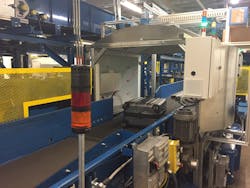What’s in Your Bag? New Screening and Tracking Technology Make for Safer Airways
Miami International Airport welcomed a slew of new employees last September, though not one of them will require a W-2 this month. The new crew is made up of 102 Mobile Inspection Tables (MIT) and is part of the airport’s design-build project for the new South and Central Terminal checked baggage system, which was awarded to Daifuku Airport Technologies in 2017.
The newly constructed, three-level Checked Bag Inspection System (CBIS) Building, used to house screening equipment and TSA personnel, went live in July of 2019. The CBIS Building is home to the Checked Baggage Reconciliation Area (CBRA) and the 102 MITs – making Miami International home to not only the largest installation of MITs, but also the largest automated guided vehicle (AGV) airport industry application in the world. Currently, Daifuku is in the process of tying in the South and Central Terminal’s into the new building, with work anticipated to be completed this year and the entire project costing $324 million.
“The remaining airlines in concourses F, G, H and J are transitioning to the new system through December 2020, when approximately 50 total airlines will be using the new system and the former South Terminal system can be demolished,” said Greg Chin, communications and digital marketing director for Miami-Dade Aviation Department.
In addition to the MITs, the Central Terminal received a new baggage handling system (BHS) to replace the airport’s older stand-alone systems, with manual screening at the ticketing and make-up level areas. The South Terminal’s BHS was revised and expanded to provide increased capacity and the latest explosive detection system (EDS) technology. The Central Terminal’s BHS sports a total conveyor count of 904 with 11 ticket counter lines and the South Terminal’s system has 1,331 conveyors with ten ticket counter lines and three curbside lines.
“The project scope includes the replacement of the entire in-line checked bag screening system for South Terminal and installation of a new checked bag screening system and automated sortation system for central terminal,” Chin said.
“We’re completely replacing the existing system for the Central Terminal,” Tim Hipp, Daifuku’s project manager at MIA, described. “Essentially, they had ticket counters going down to individual makeup units, instead of large scale sortation or inline screening. So, we are replacing the entire old system with the new upgraded system. Although the South side was relatively modern with an inline screening system, it didn’t have the new technology of screening systems – we’re up upgrading that. Additionally, we are centralizing the security screening for both the Central and South Terminals together in one location into a new building rather than having that spread out in multiple locations.”
Todd Alderman, VP of Daifuku Airport Technologies, added that while a big part of the project was geared around the aging baggage systems, the greater focus was on updating Miami’s security screening systems. For that effort, 12 CTX 9800 SEIO ISD machines, six per terminal, have been installed.
Daifuku put in the original South Terminal screening system at Miami, a process that began before 9/11 and there have been a lot of lessons learned across the industry since then in addition to an increase in the screening process, Alderman said.
“The original system was designed and installed in the early days of US screening systems prior to the rigorous screening systems that are required today. We have made many improvements since then so some of the design of the conveyors surrounding it are not best practice to today’s standards. That results in some inefficiencies, with extra bags getting falsely identified as needing to be searched which creates more work for the TSA in the hand search room,” he said. “The new machines utilize 3D imaging which enables operators to get a much better evaluation of what’s in the bag and detect a lot more – a lot broader profile of the alarming materials that they’d be looking for.”
Streamlining the process is exactly the job of the MITs, which are essentially robots that automatically transport suspect baggage to be searched directly to the TSA officers. The MITs are designed to improve the ergonomics and efficiency for the TSA officers and open the egress within the CBRA area.
“The majority of this system is still traditional belt conveyor but then we pick up the alarmed bags from the belt conveyor automatically on the Mobile Inspection Tables. The transfer is automatic and then the MIT drives the bag into the search room for the TSA,” said Alderman.
Originally, Chin added, the MITs were not part of the original plan.
“It was later incorporated to the scope of work the installation of the mobile inspection system, reconfiguration of the offices and restrooms at the second level and deferred work, such as: Inbound conveyor lines and associated crossovers and equipment, electric detection system machines in the checked baggage inspection system and associated checked baggage resolution area conveyors, sortation piers make-up devices and all associated cross-over and re-insertion conveyor lines,” Chin described.
The efficiency and increased security AGVs bring to Miami’s operations may be the most apparent on the outside, but behind the scenes the machines create a physically easier working environment for their human counterparts.
“A real advantage from the end user’s perspective is not having to physically lift the bags. The MIT bring the bags directly to the operator. If they do have to open it, they do so right on the tabletop of the MIT. Upon search completion, the TSA agent simply presses a button and the bag gets delivered right back onto the conveyor without having to do any lifting. So physically it’s better for the employees that are using the inspection rooms,” added Hipp.
Other advantages of the MITs over conventional baggage systems is the flexibility to make quick changes to the system and its layout compared to the rigidity of conveyors.
“With the Mobile Inspection Table, since we’re not tied in physically, we could change the layout or flow in a matter of minutes or hours as opposed to days to reroute something. So, if down the road TSA changes best practices on how the room should be laid out, how things should be detected, or how the process flow works, then it’s a very easy change,” Alderman described.
The MITs also cause less issues when it comes to maintenance. If a single MIT experiences a failure, it can easily be brought aside and worked on with no hinderance to the rest of the system, whereas one faulty conveyor can bring an entire BHS to a standstill. With that in mind, Hipp said that beyond the MITs, Daifuku has installed a number of redundancies into the system to prevent system standstills.
“Typically, on a conveyor, if there’s a failure of a motor or the belt and that conveyor shuts down. Since everything is sequential on a conveyor, the entire system must stop in order to fix it immediately before you are able to get the system running again. With the mobile inspection table, you are able individual parts out of the loop that may be out of service and do the maintenance on the side,” said Hipp.
Chin said construction has consisted of three distinct phases: the building, the South Terminal BHS system, then the new central terminal BHS system. Due to a highly phased construction, airport passengers have noticed little inconvenience from the extensive construction. Now that the construction is reaching its end, it will be business as usual for passengers despite the slew of new technology as they check their bags at Miami.
“We are proud to partner with the TSA on this cutting-edge facility, which is one of many enhancements coming soon as part of our airport-wide renovation and expansion. Improvements like the new baggage handling system will help MIA maintain its position as the busiest airport in Florida for international passengers,” said Lester Sola, Miami-Dade Aviation department director and CEO, at the system’s unveiling in Oct.
Beyond the Bots
Tom Gebler, account director for airports at SICK, anticipates AGVs to having a growing presence in bagging handling systems in the near future.
“I honestly think that there will be uses for AGVs in baggage handling systems. I think you're going to see a lot more of it in the next five or ten years,” said Gebler.
And while the future looms, in the immediate airports are improving their baggage handling systems and increasing efficiency by implementing technology that’s tried and true in new ways – RFID and optical technology.
RFID, which stands for radio-frequency identification, has been used for years in the postal and retail industries, but didn’t begin gaining traction in baggage systems until the late 2000s.
“RFID has been around as a technology for actually quite a while. I'd like to say that it's been possibly one of the most oversold technologies in its more infancy years, but it's really kind of come on strong as a great technology for identifying items. One of the big benefits in baggage for using RFID is that you don't need a line of sight to read the tag,” said Gebler.
The tech works by utilizing readers and antennas that emit a cloud of electromagnetic energy. This energy field excites a passive – no on-board battery or source of power – RFID tag in the 902–928 MHz frequency range, for US readers and once the RFID has been powered up by the energy cloud, it wirelessly transmits its data to the RFID reader, Gebler described.
Optical readers, Gebler said, are camera-based systems using special imagers that take multiple pictures per bag and use sophisticated algorithms to locate and decode the bar codes found on the baggage tags. These images can also be processed by Optical Character Recognition to potentially improve read rates on highly damaged codes and to extract the printed flight number and destination airport from the tag.
One issue that optical readers face is something called “bag hygiene,” where a ticket is obscured from the reader’s view for whatever reason.
“It’s when the ticket counter agent puts a bag on the belt, the tag may be obscured by passenger's ID tags. Sometimes people will put things on their bag to help them more easily identify them, like ribbons and such, that obstruct the view,” Gebler explained. “The one weakness of the optical readers is that they need to physically see the tag.”
RFID’s drawbacks come from its lagging adoption rate, due in part to the prior cost of adopting the technology before it became a widespread, multi-industry tool.
“The initial cost of RFID tags was much, much higher. Now that we have so many RFID tags produced per year for things like the retail market, as well as some airline applications, the cost of tags has come down significantly,” said Gebler.
However, the two technologies are often combined into one hybrid system, allowing for the best of both worlds and is often a smart option for airports to choose when revamping their baggage systems.
There are several reasons why airports are installing hybrid systems: while a given airport may not be currently utilizing RFID encoded tags, they want the flexibility to move to RFID encoded tags in the future, the airport may process a lot of Delta bags that are already RFID encoded and the airport wants to take advantage of improved read rates for those bags and even if the airport is generating its own RFID encoded tags it still needs to read bar code-only tags produced at other airports. Hybrid systems give them the flexibility to support both technologies for many years to come.
Gebler added that SICK offers a hybrid system that combines either lasers or cameras for reading the bar codes printed on the outside of the tag and the RFID chip and antenna inlay embedded in the tag. The system arbitrates the reading between the two identification technologies and sends the correct data to the baggage handling system.






